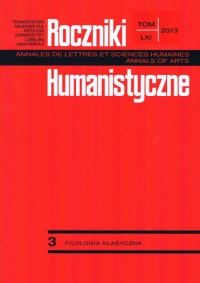„Est locus, aestifero” (Carm. I, 18) jako przykład topiki locus amoenus w poezji Wenancjusza Fortunata
Abstrakt
In this article the author presents a poem “Est locus, aestifero” which appeared in the first book of Carmina against the background of the topic locus amoenus in the poetry of Venantius Fortunatus. The poem has 18 lines and is written in elegiac meter. It is a description of the village (country estate) Bissonum, near Bordeaux. The ecphrasis, in which elements of the topic we are interested in are woven into, combines with a very clear motif of laudation. This is a characteristic feature of the poetry of Venantius Fortunatus. The Polish translation of the poem is an integral part of the essay.
Bibliografia
Auerbach A.: Język literacki i jego odbiorcy w późnym antyku łacińskim i średniowieczu, przeł. R. Urbański, Kraków 2006.
Cassingena-Trévedy F.: Son et lumière, la « matière » liturgique des Carmina de Venance Fortunat: entre l’adventus de la croix et l’icône de Martin de Tours, „Camenae” 11 (2012) (Présence et visages de Venance Fortunat XlVe centenaire), za: http://www.paris- sorbonne.fr/IMG/pdf/6Cassingena_Camenae.pdf [dostęp 21 czerwca 2013].
Curtius E.R.: Literatura europejska i łacińskie średniowiecze, tłum. i oprac. A. Borowski, Kraków 19972.
Cytowska M.: Ostatni poeta starożytności - Wenancjusz Fortunatus, „Meander” 28 (1973), z. 7-8, s. 307-320.
Gacia T.: Motyw krzyża w twórczości Wenancjusza Fortunata na przykładzie Vexilla Regis, „Roczniki Humanistyczne” 46 (1998), z. 3, s. 101-112.
Gacia T.: Topos locus amoenus w łacińskiej poezji chrześcijańskiego antyku, „Vox Patrum” 28 (2008), t. 12, s. 187-198.
Navarra L.: Venanzio Fortunato, w: Nuovo dizionario patristico e di antichità cristiane, vol. II, s. 3556-3558.
Niewiadomska M.: Wiersze o Krzyżu Wenancjusza Fortunata. Próba interpretacji, „Przegląd Tomistyczny” 9 (2003), s. 281-310.
Rolet A.: L’Arcadie chrétienne de Venance Fortunat. Un projet culturel, spirituel et social dans la Gaule mérovingienne, „Médiévales” 15 (1996), No 31, s. 109-127.
Copyright (c) 2013 Roczniki Humanistyczne

Utwór dostępny jest na licencji Creative Commons Uznanie autorstwa – Użycie niekomercyjne – Bez utworów zależnych 4.0 Międzynarodowe.





